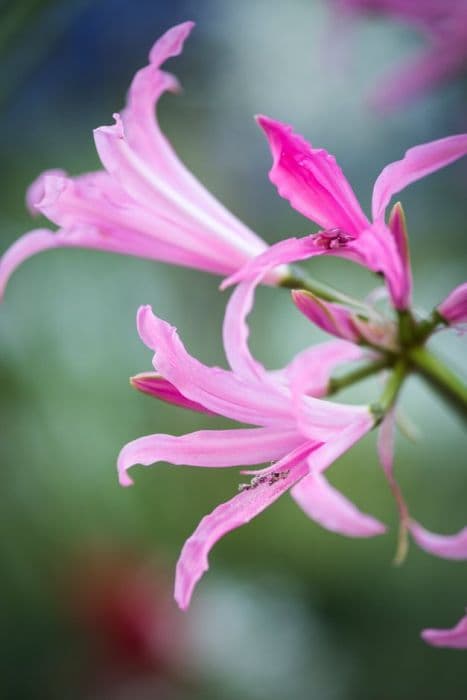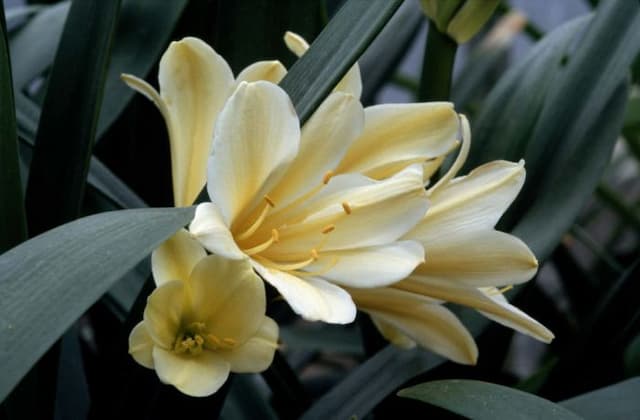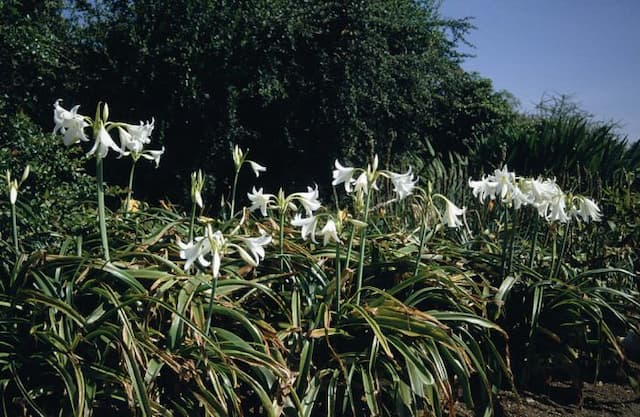Blood lily Scadoxus multiflorus
















ABOUT
The plant known as the blood lily has a striking and vivid appearance. It is recognized for its bold and spherical flower head that bursts forth in a blaze of vibrant red to orange hues, giving it a fiery and exotic look. Each of these flower heads is composed of a myriad of small florets that are tightly packed to form an almost perfect globe. At the base of the flower cluster, there are long and slender bright green leaves that come forth in a lush display. These leaves are typically glossy, adding to the plant’s overall eye-catching presence. Their elongated shape tapers to a point, and they arch gracefully, framing the spectacular bloom that rises above them on a sturdy stem. The blood lily’s bloom is further enhanced by a crown of slender bracts that radiate beneath the flower head. These bracts can have a subtle greenish or reddish tint, sometimes with a fine edge that seems to capture and accentuate the light, adding to the dramatic visual effect of the bloom. This plant is truly a showstopper in any garden or as a potted centerpiece owing to its unique and magnificent flower head. Its exotic look is often a conversation starter and it's a favorite among those who wish to add a touch of tropical flair to their surroundings.
About this plant
 Names
NamesFamily
Amaryllidaceae.
Synonyms
Blood Lily, African Blood Lily, Fireball Lily, Powder Puff Lily, Blood Flower, Katherine Wheel, Oxtongue Lily, Poison Root, Paintbrush Lily.
Common names
Haemanthus multiflorus, Haemanthus multiflorus var. katharinae, Haemanthus multiflorus var. multiflorus, Haemanthus tenuiflorus, Scadoxus multiflorus var. katharinae, Scadoxus multiflorus var. multiflorus, Scadoxus puniceus.
 Toxicity
ToxicityTo humans
The plant commonly known as Blood Lily is toxic to humans. Ingesting any part of the Blood Lily can lead to symptoms such as nausea, vomiting, abdominal pain, and diarrhea. In severe cases, it can also cause more serious effects like organ damage or organ failure due to toxic compounds such as alkaloids and cardiac glycosides that can affect the heart and other vital organs.
To pets
The Blood Lily is also toxic to pets. Consuming parts of this plant can cause symptoms similar to those in humans, including vomiting, diarrhea, abdominal pain, and lethargy. More severe poisoning can lead to cardiac issues and organ damage due to the presence of toxic compounds. Owners should seek veterinary attention immediately if their pet is suspected of ingesting Blood Lily.
 Characteristics
CharacteristicsLife cycle
Perennials
Foliage type
Evergreen
Color of leaves
Green
Flower color
Red
Height
1-2 feet (30-60 cm)
Spread
1-1.5 feet (30-45 cm)
Plant type
Bulb
Hardiness zones
9
Native area
Africa
Benefits
 General Benefits
General Benefits- Ornamental Value: Scadoxus multiflorus, also known as Blood Lily, offers striking spherical flower heads that add vibrant color and exotic appeal to gardens or as indoor displays.
- Attracts Pollinators: The bright blooms of the Blood Lily are known to attract beneficial pollinators like bees, which are essential for the health of many ecosystems.
- Low Maintenance: Blood Lily is considered to be relatively easy to care for, requiring minimal attention once established, which makes it suitable for both novice and expert gardeners.
- Drought Tolerance: Once established, the Blood Lily can tolerate periods of drought, making it an appropriate choice for xeriscaping or gardens in arid climates.
- Container Gardening: Due to its compact size, the Blood Lily is suitable for container gardening, allowing those with limited space to enjoy its beauty.
- Seasonal Interest: Blood Lily provides seasonal interest with its unique flowering pattern and has a dormancy period that can be a point of interest in understanding plant cycles.
- Educational Use: As an unusual and striking plant, the Blood Lily can be used for educational purposes to teach about plant biology and biodiversity.
 Medical Properties
Medical Properties- This plant is not used for medical purposes.
 Air-purifying Qualities
Air-purifying QualitiesThis plant is not specifically known for air purifying qualities.
 Other Uses
Other Uses- Ornamental Display: With its striking red, spherical blooms, Scadoxus multiflorus (also known as blood lily) is commonly used for ornamental purposes in gardens and as indoor plants to add a splash of color.
- Cut Flowers: The vibrant inflorescences of blood lily make for unique and exotic cut flowers, often used in floral arrangements and bouquets to make a dramatic statement.
- Psychological Well-being: The presence of blood lily in indoor environments can contribute to improved mood and reduced stress levels for individuals, due to its bright and uplifting appearance.
- Photography: Enthusiasts of botanical photography frequently seek out blood lily for its photographic appeal, capturing the brilliance of its flowers in various stages of bloom.
- Educational Tool: Botany educators use blood lily specimens to teach about plant biology and reproduction, particularly the structure and function of unique flower formations.
- Themes in Art: Artists incorporate the intriguing form of blood lily as subjects or motifs in paintings, illustrations, and other artistic works, drawing inspiration from its vivid color and shape.
- Cultural Significance: In some cultures, blood lily is associated with various myths and symbols, and is sometimes used in cultural ceremonies or festivals for its distinctive appearance.
- Conservation Education: As a unique species, blood lily is sometimes utilized in conservation educational programs to highlight the importance of plant diversity and ecological awareness.
- Container Gardening: Due to its medium size and low-maintenance nature, blood lily is well-suited for container gardening, allowing those with limited space to enjoy its beauty.
- Tattoo Design: With its eye-catching pattern and rich symbolism, blood lily serves as inspiration for tattoo designs among individuals who wish to carry a representation of nature’s art on their skin.
Interesting Facts
 Feng Shui
Feng ShuiThe Blood Lily is not used in Feng Shui practice.
 Zodiac Sign Compitability
Zodiac Sign CompitabilityThe Blood Lily is not used in astrology practice.
 Plant Symbolism
Plant Symbolism- Dazzling Beauty: The striking appearance of the Blood Lily, with its bright red, sphere-shaped flowers, symbolizes exceptional beauty that captures attention.
- Pride: The proud stance and unique shape of the Blood Lily can represent pride, suggesting confidence in one's uniqueness.
- Survival: Blood Lilies are hardy plants that can survive in various conditions, symbolizing resilience and the ability to thrive in diverse environments.
- Ephemeral Nature: The relatively short blooming period of the Blood Lily serves as a reminder of life's transient nature and the importance of living in the present moment.
 Water
WaterThe Blood Lily (Scadoxus multiflorus) should be watered thoroughly, allowing the soil to become moist but not waterlogged. During the active growing season in spring and summer, water the plant approximately once a week, with around 16 to 32 ounces of water each time, depending on the size of the pot. It is crucial to reduce watering frequency in fall and further in winter to every other week or less, adjusting the amount of water to prevent the soil from drying out completely. Always check the top inch of soil for dryness before watering again.
 Light
LightBlood Lily prefers bright, indirect light and should be placed in a location that receives filtered sunlight, such as near a window with sheer curtains or in a well-lit room without direct exposure to harsh sun rays. Avoiding direct sunlight is important as it can scorch the leaves of the plant. East or north-facing windows are often ideal spots for the Blood Lily to receive the adequate light it requires.
 Temperature
TemperatureBlood Lily thrives in warm conditions and prefers a temperature range between 60°F to 75°F. It can tolerate a minimum temperature of around 50°F, but temperatures below this can be harmful to the plant. Avoid placing the Blood Lily in areas with cold drafts or sudden temperature fluctuations to maintain its ideal growing conditions.
 Pruning
PruningPruning the Blood Lily is generally done to remove spent flowers and yellowing leaves to encourage new growth and maintain a tidy appearance. Pruning should be done after the blooming has finished, typically in late summer or fall. Cut back the foliage and flower stems to the base of the plant using clean, sharp scissors or pruning shears. Pruning is not frequently necessary, only when the plant's appearance requires it.
 Cleaning
CleaningAs needed
 Soil
SoilBlood lily thrives best in a well-draining soil mix composed of two parts peat or coco coir, one part perlite, and one part potting soil. The ideal soil pH for this plant should be slightly acidic to neutral, ranging from 6.0 to 7.0.
 Repotting
RepottingBlood lily should be repotted every two to three years or when it becomes root-bound. The best time to repot is in the spring before new growth starts.
 Humidity & Misting
Humidity & MistingBlood lily prefers high humidity levels, around 60% or higher. It is important to maintain consistent humidity for optimal growth and to mimic its natural tropical environment.
 Suitable locations
Suitable locationsIndoor
Grow Blood lily in bright, indirect light with high humidity.
Outdoor
Plant Blood lily in partial shade, protect from cold drafts.
Hardiness zone
9-11 USDA
 Life cycle
Life cycleScadoxus multiflorus, commonly known as blood lily or African blood lily, begins its life as a bulb, which remains dormant during the dry season. Upon the arrival of rain or in spring, it produces a stem and a rosette of broad leaves. During growth, the blood lily produces a single spectacular spherical flower head, consisting of numerous small red or reddish-orange flowers, which attract pollinators such as insects. After flowering, the plant sets seed, which can be dispersed by wind or wildlife, facilitating the spread of new plants. Once the seeds germinate, they grow into new bulbs, perpetuating the cycle. The leaves then die back to the bulb as the dry season approaches, with the bulb going dormant until the next favorable growth season.
 Propogation
PropogationPropogation time
Spring-Early Summer
The most popular method of propagation for the plant Scadoxus multiflorus, commonly known as blood lily, is through division of the bulbs. This is typically done when the plant is dormant, usually in the fall. Gardeners carefully unearth the bulbs and gently separate them, ensuring that each division has at least one growth point. The newly divided bulbs can then be replanted immediately, spaced about 6 inches (approximately 15 centimeters) apart. They should be placed in well-draining soil at a depth where the top of the bulb is just below the soil surface. Water the newly planted bulbs sparingly until new growth appears to prevent rot. This method allows for a relatively quick increase of blood lily plants in the garden.









